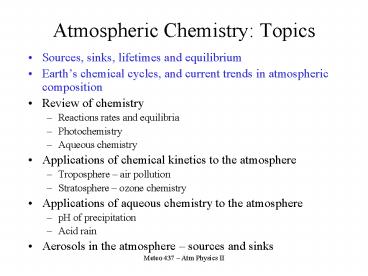Atmospheric Chemistry: Topics - PowerPoint PPT Presentation
1 / 4
Title:
Atmospheric Chemistry: Topics
Description:
Stratosphere ozone chemistry. Applications of aqueous chemistry to the atmosphere ... Troposphere and stratosphere. Boundary layer and free troposphere ... – PowerPoint PPT presentation
Number of Views:198
Avg rating:3.0/5.0
Title: Atmospheric Chemistry: Topics
1
Atmospheric Chemistry Topics
- Sources, sinks, lifetimes and equilibrium
- Earths chemical cycles, and current trends in
atmospheric composition - Review of chemistry
- Reactions rates and equilibria
- Photochemistry
- Aqueous chemistry
- Applications of chemical kinetics to the
atmosphere - Troposphere air pollution
- Stratosphere ozone chemistry
- Applications of aqueous chemistry to the
atmosphere - pH of precipitation
- Acid rain
- Aerosols in the atmosphere sources and sinks
2
Sources, sinks, lifetimes and equilibria
chemical budgets
- See Figure 3-1, Jacob. This applies to any gas
(or aerosol) in the earths atmosphere. Equation
3.7. - Lifetime, or residence time, of a chemical is the
ratio of the total amount of chemical X to the
rate of removal of chemical X from the
atmosphere. (eq 3.1). - Example. Residence time of water in the
atmosphere (ex. 3-1) - Sinks are often proportional to the amount of X
present. If so, lifetime is independent of the
amount of X present. - Example. CFC-12. (ex 3-3)
- With a source and a sink, concentrations approach
a dynamic equilibrium value. Eq (3.12), Fig 3-2. - Example. Ozone in the stratosphere.
3
Eulerian vs. Lagrangian budgets
- Eulerian budget Stay at one point in space.
Gases flow in and out undergo chemical
reactions. Equation 3.7. Suitable, e.g., for
global budgets or analysis of pollution levels
over a city. - Lagrangian budget Follow an air parcel. No
transport terms (except for turbulent diffusion).
Equation 3.18. Suitable for tracking, for
instance, a smokestack plume.
4
Two-box model
- Treats transport between two boxes of air, e.g.
- Northern and southern hemispheres
- Troposphere and stratosphere
- Boundary layer and free troposphere
- If the gases within each box are well-mixed
(equilibrium time gtgt mixing time for the box),
then we can say the transport from box 1 to box 2
is proportional to the mass (or density, or
partial pressure, or mixing ratio) of the gas in
box 1.































